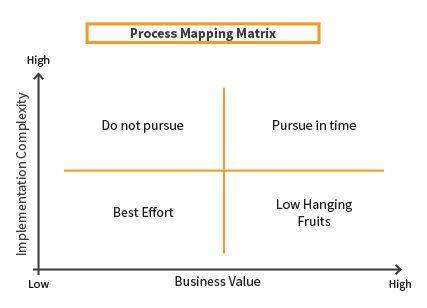In this next chapter in Mobile Enterprise Strategy, we will build up on the knowledge collected on your users and your business processes. Today’s post provides advice and guidance on building an effective roadmap to shape your mobility journey.
Step 1 – Perform a maturity assessment
Understanding where your organization stands today with respect to mobility maturity will help you set expectations on how fast you can or should move when mobilizing your business processes. The Yankee group identifies three different phases of enterprise mobility maturity.
- Opportunistic: Apps are developed on a one-off basis and there are not overarching strategy and infrastructure across the enterprise. Apps are built based on users requests rather than on actual business needs.
- Strategic: The enterprise has built a common mobility architecture to address the needs of a larger subset of the organization. Business outcomes are driving the mobilization effort and tools are used to scale policy, security and compliance across mobile assets.
- Mobile-First: At that phase, your enterprise is using mobile apps to transform business processes and drive innovation across the whole organization.
Step 2 – Evaluate your enterprise mobility readiness
This readiness evaluation can be done concurrently with your maturity assessment. Through this exercise, you look at the different facets of your organization and evaluate how prepared each one is for challenges related to mobile enablement. The critical elements to consider are:
- Strategy: The corporate strategy may need to be re-evaluated to address your mobility journey and give direction to the organization to reach its future state.
- People and Process: By measuring your employees’ readiness, you will be able to create better-suited training plans. Those plans should cover new corporate policies, processes and data security.
- Technology Architecture: You need to carefully assess your IT infrastructure current state. From there, you will be able to devise an incremental project plan to implement mobility across your enterprise.
- Corporate Policies and Regulations: Corporate policies and regulations need to address the changes mobility will bring to your organization.
The AnyPresence mobility readiness assessment toolkit is available on our website to help you benchmark your mobility readiness across two dimensions: strategic and technical. To begin your assessment, please complete this survey.
Step 3 – Map your mobility strategy to your business priorities
It is now time to take a holistic approach to your mobility strategy and determine the order in which you implement potential mobile apps, based on your business objectives. The “Business value to Complexity “ matrix provides a basic framework for this exercise. The intent is to rank business processes that make sense to mobile-enable against two criteria: implementation complexity and business value.

Implementation complexity is a high-level assessment of the level of effort to mobilize the specific process being considered. This is typically based on factors such as:
- Number and availability of source system web services the mobile app would need to integrate with
- Number of screens/views within the app, which has an impact on time and cost to develop and maintain
- Number of mobile device platforms and form-factors to support
- Number of users (internal and/or external) that are affected or would need to be trained
Business Value is a high-level assessment of the positive impact to the organization based on factors such as:
- Financial benefit in terms of cost savings or revenue generation
- Customer or partner satisfaction
- Employee or partner productivity
- Marketing or brand value
Step 4 – Define actionable plans
It is now time to build the actual roadmap. Based on your research and analysis, prioritize the different elements of your mobility initiative (new infrastructure deployments, apps development, training, etc.). For manageability purposes, break down the effort into phases, each with an expected set of outcomes. Once you have defined each of those phases, divide them into actionable steps, milestones, and owners and get started!
Step 5 – Plan for disruption
An initiative of this magnitude will create disruptions throughout the enterprise. Try to anticipate them and have a plan in place to address those challenges. It will help better manage the major changes that will occur and ensure a smoother transition overall.
Step 6 – Re-assess on a regular basis
Mobility is changing at a faster pace than any technology before. Regularly revisit your plan and strategy to make sure you are still aligned with ongoing mobility innovations, your industry progress as well as your own corporate goals and vision.